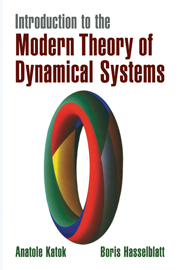Book contents
- Frontmatter
- Contents
- PREFACE
- 0 INTRODUCTION
- Part 1 Examples and fundamental concepts
- 1 FIRST EXAMPLES
- 2 EQUIVALENCE, CLASSIFICATION, AND INVARIANTS
- 3 PRINCIPAL CLASSES OF ASYMPTOTIC TOPOLOGICAL INVARIANTS
- 4 STATISTICAL BEHAVIOR OF ORBITS AND INTRODUCTION TO ERGODIC THEORY
- 5 SYSTEMS WITH SMOOTH INVARIANT MEASURES AND MORE EXAMPLES
- Part 2 Local analysis and orbit growth
- Part 3 Low-dimensional phenomena
- Part 4 Hyperbolic dynamical systems
- Appendix: BACKGROUND MATERIAL
- NOTES
- HINTS AND ANSWERS TO THE EXERCISES
- REFERENCES
- INDEX
3 - PRINCIPAL CLASSES OF ASYMPTOTIC TOPOLOGICAL INVARIANTS
Published online by Cambridge University Press: 05 June 2012
- Frontmatter
- Contents
- PREFACE
- 0 INTRODUCTION
- Part 1 Examples and fundamental concepts
- 1 FIRST EXAMPLES
- 2 EQUIVALENCE, CLASSIFICATION, AND INVARIANTS
- 3 PRINCIPAL CLASSES OF ASYMPTOTIC TOPOLOGICAL INVARIANTS
- 4 STATISTICAL BEHAVIOR OF ORBITS AND INTRODUCTION TO ERGODIC THEORY
- 5 SYSTEMS WITH SMOOTH INVARIANT MEASURES AND MORE EXAMPLES
- Part 2 Local analysis and orbit growth
- Part 3 Low-dimensional phenomena
- Part 4 Hyperbolic dynamical systems
- Appendix: BACKGROUND MATERIAL
- NOTES
- HINTS AND ANSWERS TO THE EXERCISES
- REFERENCES
- INDEX
Summary
In this chapter we will embark upon the task of systematically identifying important specific phenomena associated with the asymptotic behavior of smooth dynamical systems. We will build upon the results of our survey of specific examples in Chapter 1 as well as on the insights gained from the general structural approach outlined and illustrated in Chapter 2.
Most of the properties discussed in the present chapter are in fact topological invariants and can be defined for broad classes of topological dynamical systems, including symbolic ones. The predominance of topological invariants fits well with the picture that emerges from the considerations of Sections 2.1, 2.3, 2.4, and 2.6. The considerations of the previous chapter make it very plausible that smooth dynamical systems are virtually never differentiably stable and can only rarely be classified locally up to smooth conjugacy. In contrast, structural and the related topological stability seem to be fairly widespread phenomena.
We will consider three broad classes of asymptotic invariants: (i) growth of the numbers of orbits of various kinds and of the complexity of orbit families, (ii) types of recurrence, and (iii) asymptotic distribution and statistical behavior of orbits. The first two classes are of a purely topological nature; they are discussed in the present chapter. The last class is naturally related to ergodic theory and hence we will provide an introduction to key aspects of that subject. This will require some space so we put that material into a separate chapter. The two chapters are intimately connected.
- Type
- Chapter
- Information
- Introduction to the Modern Theory of Dynamical Systems , pp. 105 - 132Publisher: Cambridge University PressPrint publication year: 1995



